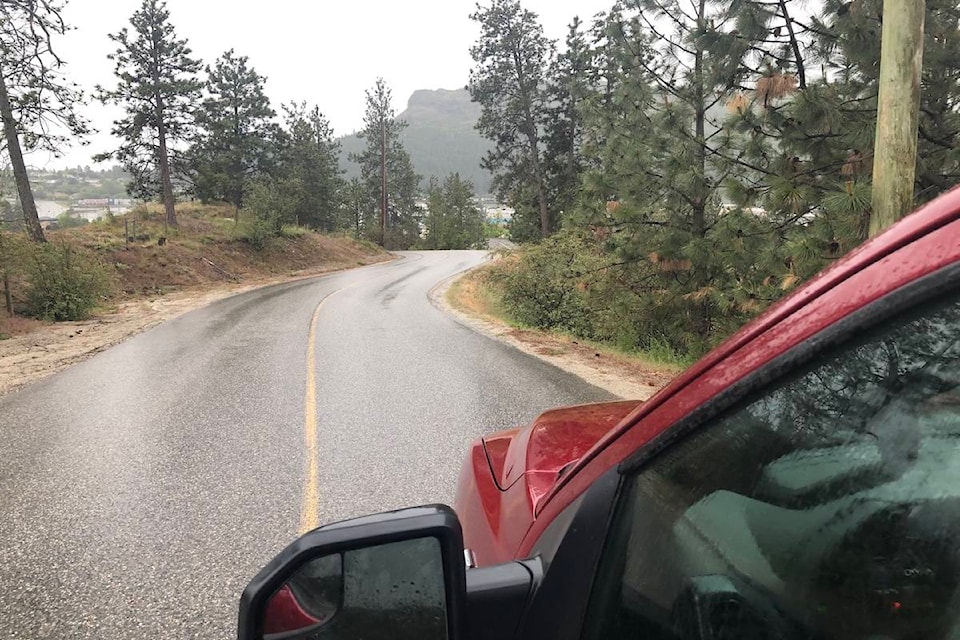It took COVID girth growth to push me to a regular walking commute for the very first time in the 13 years I’ve lived walking distance from my office.
Yes, I should be ashamed.
Much of the 18 minute walk is a narrow, twisty road called McDougall. There’s no paved shoulder or sidewalk. For much of it, there’s no unpaved shoulder either, just a narrow strip of soft sand and gravel.
Walking on the narrow strip of sand and gravel is like walking along a sandy beach. Not a surface you’d choose to walk on to get from A to B in reasonably nice shoes.
I am a stickler for facing traffic as a pedestrian. Yes, it’s the law. But more than that, I have acted for pedestrian clients who have been mowed down from behind by clueless motorists.
Is it fair to call them clueless, defined as “having no knowledge, understanding, or ability”. Better would be “clued out”. Drivers can see, but not mentally process, important visual information like the existence of a pedestrian. It’s called “ inattentional blindness ”
By facing traffic, you have the opportunity to leap out of the way if you see a clued out motorist about to mow you down.
The “facing traffic” rule comes from section 182(2) of the Motor Vehicle Act If there’s a sidewalk, you must walk on it. But if no sidewalk “…a pedestrian walking along or on a highway must walk only on the extreme left side of the roadway or the shoulder of the highway, facing traffic approaching from the opposite direction.”
Don’t get distracted by the word “highway” Section 1 of the Act defines “highway” as including “every road, street, lane or right of way designed or intended for or used by the general public for the passage of vehicles”.
If ever there was a stretch of road where facing traffic is important, it would be McDougall.
The road is so narrow that a vehicle could not safely pass by a pedestrian without either moving over into the oncoming lane or slowing right down.
And visibility is compromised by sharp, blind curves.
Please take care not to be a clued out when behind the wheel. Please do your best to be continually mindful of the important task at hand, keeping your brain free from other unintentional (daydreaming) or intentional (cell phone discussion) cognitive load.
And please keep a sharp eye out, assuming that a pedestrian might be around every corner.
There is an overarching obligation on motorists to be careful around pedestrians. It’s a matter of common sense and moral decency! But it also comes from section 181(a) of the Act which mandates a driver to “exercise due care to avoid colliding with a pedestrian who is on the highway”.
Now for the fun part.
You’re driving along a narrow road with blind corners and no shoulder and you encounter a pedestrian on your side of the road. Do you feel a sense of entitlement, expecting the pedestrian to step off the road, into the ditch if necessary, to save you from having to slow right down to pass?
What about if you’re the pedestrian? Do feel a sense of entitlement, expecting the motorist to slow right down to pass by you, so that you can continue walking comfortably along the edge of the pavement?
Of the two, the pedestrian has the legal entitlement.
And what would be the most sensible from an etiquette standpoint? Who should accommodate the other: the person sitting comfortably in an automobile having to adjust with the push of a pedal and turn of a steering wheel, or the person commuting on foot?
I’m no longer doing the walking commute. I overdid it and have to take a break, which doesn’t bode well for a future return!
The experience helped me better consider, and hopefully articulate, ideas about motorists and pedestrians sharing the road.
Which includes a strong suggestions to pedestrians, when encountering considerate and rule following motorists, to give them a big smile and a wave with a mouthed “thank you”. The warmer motorists hold pedestrians in their hearts, the more likely they will show the careful consideration pedestrians deserve.
Missed last week’s column?
HERGOTT: Accountability of being a pet owner
About Paul Hergott, Personal Injury Lawyer:
Paul began practicing law in 1995 in a general litigation practice. Of the various areas of litigation, he became most drawn to and passionate about pursuing fair compensation for personal injury victims, which has gradually became his exclusive area of practice. Paul’s practice is restricted to acting only for the injured victim, never for ICBC nor for other insurance companies.
Instagram: https://www.instagram.com/hergottlaw/
Facebook: https://www.facebook.com/personalinjurylawfirm/
Twitter: https://twitter.com/hergott_law?lang=en
YouTube: https://www.youtube.com/c/HlawCanada
